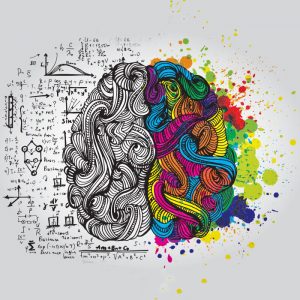
Understanding and Harnessing the Creative Spark
“The intuitive mind is a sacred gift and the rational mind is a faithful servant. We have created a society that honors the servant and has forgotten the gift.” – Albert Einstein
In studying marketing or advertising in college, we are primarily taught to leverage the strength of our left brain to understand the four “Ps” of marketing, target audiences, demographics, and the mechanics of an ad campaign and its potential for creating a response.
We generally operate within the cognitive realm whereby we use reasoning, perception, and judgment to determine how to create results for clients. The approach is logical and analytical and is innate to the learning experience, particularly now with the advances in technology and the wealth of data we have at our fingertips about human activity.
Left vs. Right-Brain Advertising
In the Mad Men era of the 1950s, advertising and marketing was considered more of a right brain job. With less data available, creatives relied on intuition, inspiration, and those “aha” moments. Today more of what we study is based on black and white data-driven concepts versus abstract information. Analytics now dominate the field of advertising.
We have to understand how a media buy will perform; we must understand how to perform A/B split testing, and we need to be sure that the estimated ROI we establish for a campaign is measurable and achievable. We are in the business of helping clients grow their businesses and organizations, and that means that what we do must create results and improve the bottom line.
But the interesting thing about this industry is that the right brain work is still required and quite frequently where the magic happens. It is that other realm in which we operate frequently that is harder to quantify. It’s that “something extra” in our work that can be hard to describe. It is the creative spark that connects all of the dots and makes the product truly resonate with its audience.
In the process of building creative products whether a website, video production, or social media campaign, connecting with and embodying a brand’s humanity and brand personality is paramount. That being said, the process of brand discovery, a SWOT analysis, research, and competitive analysis will all inform us in this creative process.
Expertise and Emotion: A Balancing Act
We become experts in our clients’ industries because that is one of the keys to developing great work. We must know the undercurrent of what is happening in the marketplace and how to correctly position a client. But our work goes beyond education, research, and an application of marketing principles and media strategy. At some point in this process, we pass the baton off to our right brain, the creative and intuitive realm. Creative directors, copywriters, marketing strategists, and all other creative professionals must cross this divide daily in our work. Does the ad feel right? Does it inspire us? You know the moment when you see it. It is the “wow” factor that has instant emotional impact.
Creativity with a Conscience
While this realm is intuitive and emotional in nature, it can be cultivated. We can sharpen our senses and become better at tapping into this well of creativity and inspiration. Some of the keys to building this area of aptitude within us are to consider the pain points of the target audience as it relates to the product or service we are marketing. With those problems (real or perceived) in mind, what solutions would ease their pain? We must develop empathy and walk in the shoes of the audience for a moment.
Creative professionals can be like psychologists in some ways. This work demands that one become familiar with human nature, eternal truths, and the subconscious mind. As marketing professionals, a large part of what we do is study human nature at its core. A basic requirement for this work: a deep respect for the human experience.
When our left and right brain are both involved, perhaps at different stages, that is usually when the best work happens. Don’t let that left brain outrun its counterpart. You need both to succeed.